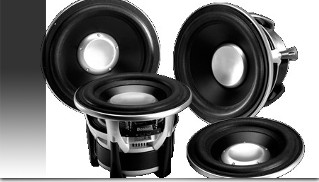 If you want good sounding audio in your car, then you are going to need a good set of audio speakers. The problem is, though, what constitutes a good set of speakers? In this article we will review the ins and outs of perhaps the most important part of the automotive audio experience.
If you want good sounding audio in your car, then you are going to need a good set of audio speakers. The problem is, though, what constitutes a good set of speakers? In this article we will review the ins and outs of perhaps the most important part of the automotive audio experience.
First, a Little about “Sound”
As you may know, sound is a “wave of pressure” that moves through the air. Air molecules are the physical mechanism by which the wave moves. When such pressure waves reach your eardrums and cause them to vibrate, the brain interprets this as sound.
Sound waves or vibrations are expressed in hertz, also known as cycles per second. The lower the frequency of these vibrations (the less they occur per second), the lower the pitch of the sound. The higher the frequency of these vibrations (or, the more they occur per second), then the higher the pitch of the sound. You probably know these opposite ends of the sound spectrum by the terms bass and treble.
Human hearing is limited to a certain range of frequencies, usually from 20-18,000 hertz. The deepest bass note we can hear is around 20 hertz (although at lower frequencies one “feels” more than actually “hears” sounds) and the highest treble frequencies are at about 18,000 hertz.
The loudness of sound is measured in decibels (dB). With minimal background noise, we can hear very soft sounds well under 50 dB. Most normal speech is at 60 dB, and around 80 dB or so, sounds start to get pretty loud. Prolonged exposure to about 90 db can actually damage your hearing.
How Do Speakers Work?
Speakers are electro-mechanical devices that create the waves of air pressure that we perceive as sound. Here’s how they work. First, inside every speaker is a driver. Drivers convert electrical energy (from an amplifier) into mechanical energy, which is the movement of a speaker cone. When speaker cones drive air, then a wave of air pressure is created. This wave exits the speaker cone and eventually travels to your ears. Your ears and associated brain mechanisms convert this wave energy into sound.
Specialized Speakers
The most basic speaker in a car audio system is called a “full-range” speaker since it’s designed to reproduce the full frequency range of human hearing. Full range speakers work well enough but it’s difficult for any one speaker design to cover the full range of hearing.
A better approach is to use specialized speakers that are designed to reproduce a smaller, specific part of the hearing range. Tweeters, for example, reproduce high frequencies since their small cones can move very quickly. Woofers are larger speakers that move lots more air and create the bass frequencies. Today. all high-end car audio systems utilize tweeters and woofers and perhaps other drivers.
Crossing Over
It takes much more power to move the large cone of a woofer than the small cone of a tweeter so it makes sense to split the frequencies apart and deal with them separately. Crossover circuitry divides the audio signal into parts. This allows the specialized speakers, such as tweeters and woofers, to get the audio signals they’re designed to reproduce and the amount of power they are designed to handle.
The service folks at deerybrotherschryslerdodgejeepram.com suggest that when shopping for automotive speakers you should look for good quality. Speakers that offer inflated power handling and flash packaging are often poor choices. Spend time reading reviews and, if possible, audition the speakers with several audio sources.
Article Source Material: Deery Brothers CDJR